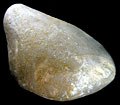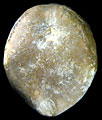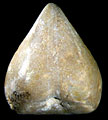Archiacia is very similar to Claviaster, both genera having inflated tests, with a high, drawn-out cylindrical prominence overhanging the anterior margin, double pored phyllodes and a non-petaloid ambulacrum III. These genera differ in that ambulacrum III of Archiacia has a double series of double pores, while ambulacrum III in Claviaster has a single series of double pores.
Szorenyi (1955, text-fig. 26) shows single pores in ambulacrum III of Archiacia hungarica. Kier (1962, p. 154) reports that all the specimens of Archiacia he has seen have the pores paired, and suspects that Szorenyi\'s drawings are not accurate.
Agassiz, L. & Desor, E. 1846-1847. Catalogue raisonné des familles, des genres, et des espèces de la classe des échinodermes. Annales des Sciences Naturelles, Troisième Série, Zoologie: 6 (1846), 305-374, pls 15-16; 7 (1847), 129-168; 8 (1847), 5-35, 355-380.
P. M. Kier. 1962. Revision of the cassiduloid echinoids. Smithsonian Miscellaneous Collections, 144 (3) 262 pp.
E. Szorenyi. 1955. Echinides Cretaces de la Bakony. Geologica Hungarica, series Palaeontologica, 26, 268 pp., 22 pls.




